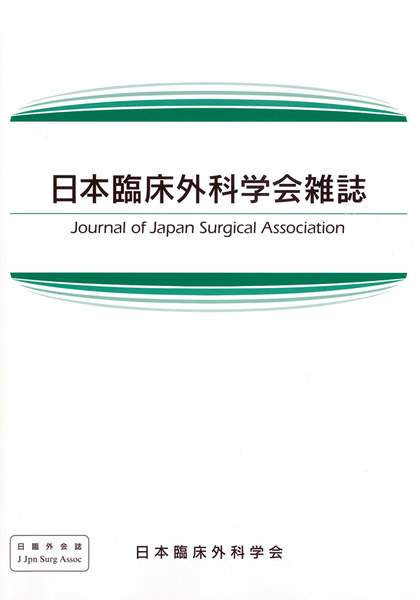All issues

Volume 71, Issue 1
Displaying 51-57 of 57 articles from this issue
Case Reports
-
Hiroyuki HOSHINO, Taketo SAITO, Kazunori NOJIRI, Susumu HIRANO, Tadao ...2010 Volume 71 Issue 1 Pages 243-247
Published: 2010
Released on J-STAGE: July 16, 2010
JOURNAL FREE ACCESSVenous aneurysm (VA) is defined as a localized dilating lesion of the vein without accompanying by venous ectasia and elongation. It has been reported that VA affects various veins from the central to peripheral veins of the extremities. It is a rare entity and the etiology has not been clarified. VA involving the popliteal vein can cause pulmonary embolism. In this paper we present our experience with two cases of popliteal venous aneurysm (PVA).
Case 1 : A 42-year-old man complaining of dyspnea was admitted to the hospital with a diagnosis of bilateral pulmonary embolism. CT scan showed a VA 3cm in diameter with thrombi at the right popliteal vein. Anticoagulant therapy was thus started. Pulmonary embolism recurred while the patient stood by for scheduled surgery. Accordingly a permanent filter for the inferior vena cava was placed and thereafter plication suture of VA was performed.
Case 2 : A 35-year-old man was found to have a left PVA 2cm in diameter without thrombi by MRI while he had been followed for a bruise on the left knee at a traffic accident, and he was referred and admitted to the hospital. We performed plication suture of VA like in the case 1.View full abstractDownload PDF (431K) -
Yukihiro MINAGAWA, Shigeaki BABA, Masahumi KOHNOSU, Osamu SHIMOOKI, Ta ...2010 Volume 71 Issue 1 Pages 248-251
Published: 2010
Released on J-STAGE: July 16, 2010
JOURNAL FREE ACCESSWe report a patient with Muir-Torre syndrome. A 46-year-old man had a lesion in the transverse colon and a 2-cm lesion on the skin of his back. The patient underwent transverse colectomy and resection of the skin tumor. On pathology, the transverse colon lesion was a stage IIa (pT3N0M0), moderately differentiated adenocarcinoma. The lesion of the skin on his back was a sebaceous carcinoma. The patient's mother had died of cancer when the patient was five years old. He has had no recurrences during 6 months of follow up.View full abstractDownload PDF (304K) -
Shigemi MORISHITA, Masaki KITOU2010 Volume 71 Issue 1 Pages 252-256
Published: 2010
Released on J-STAGE: July 16, 2010
JOURNAL FREE ACCESSSpinal epidural abscess is a complication of continuous epidural block. We describe a 69-year-old women who developed an epidural catheter-related epidural abscess 11 days after left lower lobectomy for lung cancer. Magnetic resonance imaging of the spine was essential for the diagnosis of epidural abscess and for determining the extent of spread. The patient was treated by aspiration of epidural pus and administration of appropriate antibiotics. Since Methicillin-resistant Staphylococcus aureus (MRSA) was detected in an epidural pus culture, we changed the antibiotic to VCM and continued intravenous administration therapy. She recovered from the abscess without neurological deficits. Staphylococcus aureus is the most common causative bacterium of spinal abscess and MRSA has recently become the major species. Epidural abscess management consists of early diagnosis and therapy. Early check-up and treatment should be started for patients undergoing continuous epidural block who demonstrate high fever complicated by back pain.View full abstractDownload PDF (316K) -
Mitsuaki MORIMOTO, Ken SHIRABE, Taisuke TOYOMASU, Takashi NAGAIE2010 Volume 71 Issue 1 Pages 257-261
Published: 2010
Released on J-STAGE: July 16, 2010
JOURNAL FREE ACCESSWe report a case of metachronous quadruple cancer (gastric cancer, laryngeal cancer, colon cancer, and hepatocellular carcinoma) in a 76-year-old man. He had undergone surgery for gastric cancer in 1998 and radiotherapy for laryngeal cancer (Stage I) in 2004. A liver tumor was detected on computed tomography in 2005. A partial hepatectomy was performed in 2005. Then, in 2007 early ascending colon cancer was detected on colonoscopy ; endoscopic mucosal resection was performed.
Pathologically, the gastric cancer was a signet ring cell carcinoma with no submucosal invasion, T1, N0, and Stage I ; the hepatic cancer was moderately differentiated hepatocellular carcinoma, T2, N0, and Stage II ; the colonic cancer was well differentiated adenocarcinoma focally invading the submucosa, ly0, v0, and Stage I.
As the number of patients with multiple primary cancers is increasing. Cancer patients should be carefully examined given the possibility of multiple cancers.View full abstractDownload PDF (367K)
-
2010 Volume 71 Issue 1 Pages 262-278
Published: 2010
Released on J-STAGE: March 22, 2011
JOURNAL FREE ACCESSDownload PDF (817K)
-
2010 Volume 71 Issue 1 Pages 283-284
Published: 2010
Released on J-STAGE: March 22, 2011
JOURNAL FREE ACCESSDownload PDF (203K)
-
[in Japanese]2010 Volume 71 Issue 1 Pages 334
Published: 2010
Released on J-STAGE: November 16, 2011
JOURNAL FREE ACCESSDownload PDF (127K)